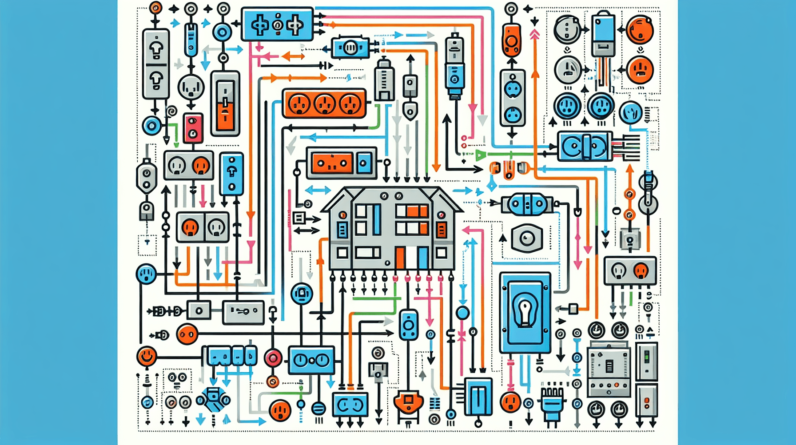

Have you ever wondered how the electrical wiring in your home works? Understanding your home’s electrical system can be quite beneficial, especially when it comes to safety and maintenance. Knowledge of wiring can also empower you when it’s time to tackle home improvements or renovations.
The Basics of Residential Electrical Wiring
Before diving into wiring diagrams, it’s essential to grasp the basic components of residential electrical systems. Your home electrical system is designed to distribute electricity safely throughout your living space for your appliances, lighting, and more.
The Main Components of Electrical Wiring
Every electrical wiring system consists of several key elements:
- Service Entrance: This is where electricity enters your home from the grid, often through a meter and main panel.
- Main Circuit Breaker: This device controls the flow of electricity to your house and protects against overload.
- Wiring: The copper or aluminum cables running through your walls provide power to various fixtures and appliances.
- Outlets: These are the points where you plug in devices and appliances.
- Light Fixtures: These components are essential for illumination and can vary widely in type and function.
- Grounding System: This safety feature protects against electrical surges and faults, directing excess electricity safely away from your important devices.
Understanding these components gives you a solid foundation as we move on to wiring diagrams.
Understanding Wiring Diagrams
A wiring diagram is a visual representation of an electrical circuit that illustrates how various components are interconnected. Familiarizing yourself with these diagrams can help you comprehend DIY projects and identify potential issues.
Importance of Wiring Diagrams
- Troubleshooting: If you experience an electrical problem, a wiring diagram can help you pinpoint where the issue lies.
- Installation Guides: Having a clear visual reference makes it easier to install new fixtures or components.
- Regulatory Compliance: Following wiring diagrams that adhere to local codes is crucial for safety and legality.

Types of Wiring Diagrams
There are several types of wiring diagrams, each serving different purposes. Recognizing the types can help you choose the right one for your needs.
Schematic Diagrams
Schematic diagrams simplify the presentation of electrical circuits by using symbols to represent components. They do not show the physical layout but instead focus on how components interconnect.
Pictorial Diagrams
Pictorial diagrams provide a more visual representation of wiring by showing physical layouts and components as they would appear in your home. This can be particularly useful for those who appreciate a more tangible view.
Block Diagrams
Block diagrams represent large sections of a system rather than individual components. They are ideal for displaying how various systems connect, such as how home lighting connects to your main panel.
Creating Your Wiring Diagram
Creating your wiring diagram requires careful planning. After all, it’s crucial to follow safety guidelines and local building codes. Here’s a general process to help you get started.
Step 1: Gather Your Tools and Materials
- Graph paper or wiring diagram software: This is essential for creating a clean and easy-to-read diagram.
- Pencil and ruler or drawing tools: These will help you make straight lines and perfect shapes for components.
- List of components: Have on hand the devices and fixtures you plan to install.
Step 2: Determine Your Load Requirements
Understanding how much power each device uses is critical for determining the size of your electrical circuits. Make a list of the appliances, outlets, and fixtures you plan to wire.
| Appliance/Fixture | Wattage |
|---|---|
| Refrigerator | 800 |
| Microwave | 1200 |
| Dining room lights | 200 |
| Living room outlets | 1800 |
| Washer and dryer | 4000 |
Step 3: Map Out the Layout
Using graph paper or software, start sketching your home layout. Begin by marking where the main panel is located. From here, you can plan out where the outlets and switches will go, based on your load requirements.
Step 4: Draw Your Circuits
Make sure you follow local electrical codes while laying out your circuits. Each circuit should be clearly marked with what devices will be connected to it.

Common Electrical Wiring Configurations
In residential wiring, there are several configurations that are commonly used. Each serves a specific function and fits different situations.
15-Amp Circuits
These circuits are commonly used for general-purpose outlets requiring a 15-amp circuit breaker. They’re perfect for small appliances and lighting.
20-Amp Circuits
For heavier load requirements, you’ll want to consider 20-amp circuits. These are suitable for high-wattage appliances like toasters and hair dryers.
Dedicated Circuits
Certain appliances, like refrigerators and microwaves, may require dedicated circuits to handle their high power demands without tripping a breaker. Always include these considerations in your diagram.

Safety Considerations for Electrical Wiring
Safety should always be your top priority when working with electricity. Familiarize yourself with important safety practices.
Use the Right Materials
Always use wiring, circuit breakers, and devices that meet or exceed the necessary ratings for your home. This will help prevent overheating and potential fire hazards.
Circuit Breakers
Ensure your circuit breakers are correctly rated for the circuits they protect. Properly rated breakers will trip if there’s an overload, preventing equipment damage and addressing safety issues.
Grounding
Grounding your electrical system is critical for safety. Always double-check that you have a proper grounding system in place, as it helps mitigate electrical shocks and damage to appliances.
Understanding Electrical Codes
Every electrical system must comply with local codes. Understanding these regulations is vital for the safety of your home.
National Electrical Code (NEC)
In the United States, the NEC outlines accepted standards for electrical wiring. Familiarizing yourself with these codes will help you prevent hazards and make your projects compliant.
Local Codes
Local amendments may exist to the NEC, so always consult your local building department or a licensed electrician for guidance. This helps you avoid potential fines or harassment from regulations and ensures your work is safe and legal.
Common Electrical Wiring Issues
While understanding your electrical wiring is empowering, being aware of common problems can help you act quickly to resolve them when they arise.
Overloading Circuits
One of the most prevalent issues is circuit overload, which occurs when too many devices draw power from a single circuit. It’s important to distribute your electrical load evenly across circuits.
Short Circuits
Short circuits can happen when wires become damaged or when a hot wire contacts a neutral wire. This can lead to electrical fires or damage to components.
Ground Faults
Ground faults occur when electrical current strays outside its intended path, often due to faulty insulation or water intrusion. Installing ground fault circuit interrupters (GFCIs) in areas like kitchens and bathrooms can mitigate this risk significantly.
Hiring an Electrician
Sometimes, the safest and most effective solution is to hire a professional. Understanding when to seek help is crucial to maintaining safety in your home.
When to Call an Electrician
- Complex Issues: If you encounter problems that seem beyond your expertise, don’t hesitate to contact a licensed electrician.
- Major Renovations: Bring in a professional during major electrical renovations to ensure everything is up to code and safe.
- Inexperienced: If you’re unsure about how to tackle your wiring project, it’s always best to consult with someone qualified.
Questions to Ask When Hiring an Electrician
When selecting an electrician, consider asking the following questions:
- Do you have proper licensing and insurance?
- What is your experience with projects similar to mine?
- Can you provide a detailed estimate before starting work?
- Will you provide a warranty for the work completed?
Conclusion
Understanding electrical wiring in your house is an invaluable skill. Armed with the right knowledge, tools, and safety practices, you can tackle minor projects, troubleshoot issues, and even embark on larger renovations with confidence. Always prioritize safety and don’t hesitate to ask for help when you need it.
As you proceed on your electrical journey, remember that careful planning, adherence to codes, and respect for the power you’re working with are essential. Whether you’re a DIY enthusiast or someone simply wanting to learn more about your home, this knowledge serves you well. Happy wiring!






